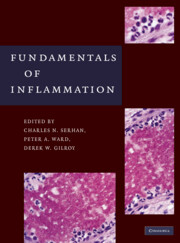Book contents
- Frontmatter
- Contents
- Contributors
- Preface
- PART I THE INFLAMMATORY RESPONSE – AN OVERVIEW
- PART II INDIVIDUAL CELL TYPES
- 4A Neutrophils I
- 4B Neutrophils II
- 5 Mast Cells as Sentinels of Inflammation
- 6 Basophils
- 7 Eosinophils
- 8 Macrophages
- 9 Lymphocytes
- 10 Fibroblasts and Stromal Cells
- 11 Neutrophil–Endothelial Cell Interactions
- PART III CHEMICAL MEDIATORS
- PART IV IMMUNOPHARMACOLOGY
- PART V INFLAMMATORY DISEASES/HISTOLOGY
- PART VI ANIMAL MODELS OF INFLAMMATION
- Index
- References
11 - Neutrophil–Endothelial Cell Interactions
from PART II - INDIVIDUAL CELL TYPES
Published online by Cambridge University Press: 05 April 2014
- Frontmatter
- Contents
- Contributors
- Preface
- PART I THE INFLAMMATORY RESPONSE – AN OVERVIEW
- PART II INDIVIDUAL CELL TYPES
- 4A Neutrophils I
- 4B Neutrophils II
- 5 Mast Cells as Sentinels of Inflammation
- 6 Basophils
- 7 Eosinophils
- 8 Macrophages
- 9 Lymphocytes
- 10 Fibroblasts and Stromal Cells
- 11 Neutrophil–Endothelial Cell Interactions
- PART III CHEMICAL MEDIATORS
- PART IV IMMUNOPHARMACOLOGY
- PART V INFLAMMATORY DISEASES/HISTOLOGY
- PART VI ANIMAL MODELS OF INFLAMMATION
- Index
- References
Summary
INTRODUCTION
Neutrophils (polymorphonuclear leukocytes, PMN) have a clearly defined role in inflammation. In response to injury or infection, PMN migration across vascular endothelial cells is a first line of defense against infectious agents, and defects in such PMN–endothelial interactions contributes to fulminate microbial infections, mucosal ulcerations, and delayed tissue healing. The protective aspects of PMN in disease are objectively exemplified by the clinical observation that patients with primary defects in PMN function, including neutropenia and genetic PMN immunopathologies (e.g., leukocyte adhesion deficiencies, chronic granulomatous disease, Chediak–Higashi syndrome, myeloperoxidase deficiency, etc.), exhibit ongoing mucosal infections.
This chapter focuses on our current understanding of how PMN interact with vascular endothelial cells under physiologic and pathophysiologic conditions (Figure 11.1).
MOLECULAR MECHANISMS OF PMN ADHESION AND TRANSMIGRATION
PMN migration across the endothelial surface is a result of an orchestrated series of events, ultimately resulting in PMN accumulation at sites of tissue injury. The recruitment signals, the cell–cell interaction steps, and the regulatory pathways for these events have been an area of extensive exploration in the past two decades. A number of recent reviews have addressed these steps in detail [1 –4]. Here, we will summarize some of the major steps and guide the reader to the primary literature for more insight into this dynamic process.
- Type
- Chapter
- Information
- Fundamentals of Inflammation , pp. 141 - 152Publisher: Cambridge University PressPrint publication year: 2010



